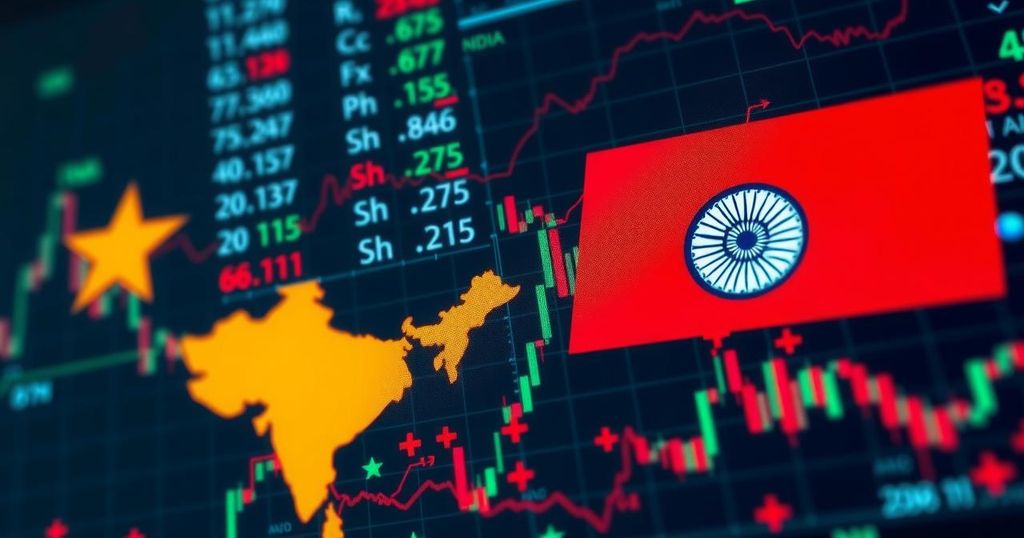Evaluating the Impact of China’s Stimulus on Foreign Capital Outflows from India
Foreign capital is flowing from India to China as investors respond to China’s stimulus measures aimed at economic recovery. While there has been significant selling by foreign portfolio investors, analysts predict this trend may not persist due to the potential challenges within China’s economy. Experts maintain that India’s robust economic fundamentals and long-term growth potential will continue to attract investment.
The Indian stock market is currently witnessing an uptick in foreign capital outflows as foreign portfolio investors (FPIs) pivot towards China, following the latter’s recent stimulus initiatives aimed at rejuvenating its economy. China’s stimulus measures, announced in late September and October, encompass a series of strategies including reductions in reserve requirements, mortgage rate cuts, and significant liquidity infusions designed to spur overall economic growth in the country. Previously attractive market valuations in China have drawn considerable investor interest. Recent data reveals that FPIs have divested approximately ₹82,845 crore from Indian equities throughout October, up until the 21st of the month. Despite this growing trend, analysts caution that the flight of capital from India may not be sustained in the long term due to underlying structural challenges facing China’s economy, compounded by its elevated debt-to-GDP ratio. V K Vijayakumar, Chief Investment Strategist at Geojit Financial Services, articulated, “The FPI selling can continue for some more time. However, this is unlikely to sustain for long. This enthusiasm for Chinese revival is unlikely to last long because China has some structural problems. Even their fiscal stimulus is unlikely to continue beyond a point…”. China’s central bank has implemented its most substantial stimulus measures since the onset of the pandemic, introducing cuts to its benchmark lending rates that further taper financial costs. Notable cuts include a 25 basis point decrease in the one-year loan prime rate, now at 3.10% from 3.35%, and a corresponding reduction in the five-year loan prime rate to 3.60% from a prior 3.85%. These adjustments depict a continued effort by the People’s Bank of China to support economic growth and narrow the gap toward government-mandated growth targets. Recent price rallies among Chinese stocks have outperformed global markets, raising valuation disparities between India and China. In response to the stimulus news, some investors have quickly shifted strategies to capitalize on potential gains in the Chinese market. Nevertheless, experts note that this trend is likely to revert, given the resilience and future growth prospects of the Indian economy, which remains robust amidst these emerging market dynamics. Shruti Jain, Chief Strategy Officer at Arihant Capital Markets, emphasized the strength of India’s long-term economic story, stating, “India is a long-term story that is much more stable and predictable…” Additionally, the increased attention from global funds towards China is anticipated to positively impact India, as the latter could benefit from heightened portfolio allocations given its existing position as a favored investment destination. Analysts further posit that growth revival in the Chinese economy, particularly within the housing and infrastructure sectors, may yield beneficial outcomes for Indian businesses. It has been suggested that this could heighten domestic steel demand in China, potentially reducing the impact of Chinese steel exports that have historically challenged Indian manufacturers. Narinder Wadhwa, Managing Director of SKI Capital, noted that despite the allure of the Chinese market fueled by stimulus measures, the prospects of enduring structural problems elsewhere will solidify India’s standing as a preferable long-term investment location. In summation, India’s economic fundamentals continue to present solid long-term growth opportunities, even in the face of short-term capital outflows related to Chinese economic stimuli. Amit Goel, co-founder and chief global strategist at Pace 360, reiterated the sentiment that while China’s stimulus initiatives may temporarily enhance its market appeal, the narrative surrounding India’s economic resilience remains compelling for discerning investors.
The article examines the implications of China’s recent stimulus package on the Indian stock market, focusing on the rising trend of foreign capital outflows from India as investors increasingly adopt a ‘sell India, buy China’ strategy. China’s stimulus efforts, aimed at revitalizing its economy, have attracted investor attention due to favorable market valuations. While Indian equities have experienced significant FPI divestments, several financial experts express caution regarding the sustainability of this trend, highlighting the structural economic challenges that China faces.
In conclusion, China’s recent stimulus measures have prompted a noticeable shift in foreign investment strategies, with some capital flowing out of the Indian market. However, experts believe that the factors influencing this trend, particularly the underlying economic challenges in China, will likely temper its longevity. India’s economic fundamentals continue to be robust, positioning it as a more stable long-term investment destination. As global investors reassess their portfolios, it is anticipated that India will maintain its attractiveness, supported by the anticipated benefits arising from revived Chinese demand in specific sectors, particularly steel.
Original Source: www.livemint.com








Post Comment